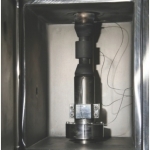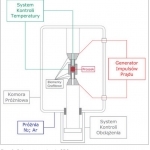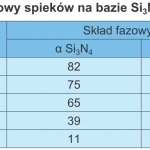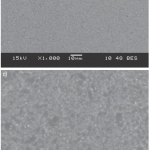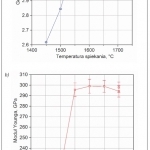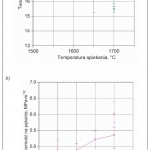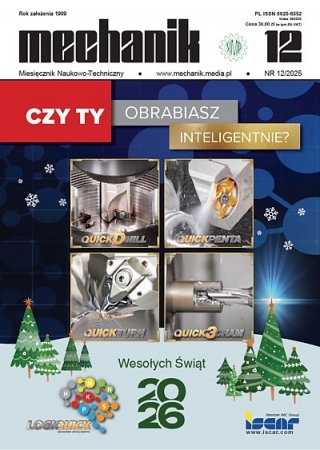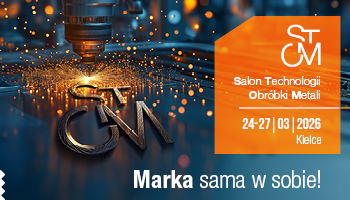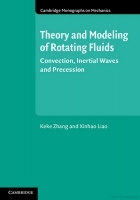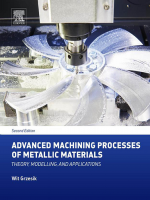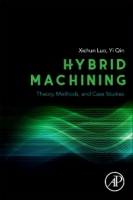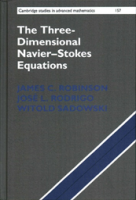Spiekanie ceramiki azotkowej metodą SPS *
SPS sintering of nitride ceramics
Author: Piotr Wyżga, Piotr Klimczyk, Jolanta Cyboroń, Paweł Figiel
Mechanik nr 05/06/2019 - Biuletyn Instytutu Zaawansowanych Technologii Wytwarzania
STRESZCZENIE: Ze względu na wyjątkowe właściwości ceramiki azotkowej jest ona bardzo często wykorzystywana w szeroko pojętej technice. Otrzymywanie wyrobów z azotku krzemu wiąże się jednak z koniecznością stosowania zaawansowanych metod, gdyż ten materiał jest trudno spiekalny. W wyniku spiekania prądem impulsowym SPS/FAST (spark plasma sintering/field assisted sintering technique) otrzymano gęste spieki ceramiczne z układu Si3N4-Al2O3-Y2O3. Parametry spiekania mieszanki zoptymalizowano tak, aby uzyskać możliwie najwyższe parametry spieków, takie jak: gęstość, moduł Younga, twardość i odporność na pękanie. W ramach pracy analizowano wpływ ciśnienia i prądu impulsowego, stosowanych w metodzie SPS/FAST, na spiekalność oraz na wybrane właściwości fizyczne i mechaniczne otrzymanych materiałów. Celem wprowadzenia do osnowy Si3N4 dodatków Al2O3 i Y2O3 była aktywacja trudno spiekalnego proszku azotku krzemu i w konsekwencji – osiągnięcie wysokiej gęstości otrzymanego spieku. Najlepszymi właściwościami charakteryzował się spiek otrzymany w temperaturze 1700°C i pod ciśnieniem 63 MPa; czas wytrzymania w temperaturze spiekania wynosił 15 min. Gęstość uzyskanej próbki osiągnęła 98% wartości teoretycznej, a pozostałe parametry wynosiły: moduł Younga – 298 GPa, twardość Vickersa – 17,7 GPa, odporność na pękanie powierzchniowe – 6 MPa∙m1/2.
SŁOWA KLUCZOWE: Si3N4, spiekanie SPS, moduł Younga, twardość
ABSTRACT: Due to the unique properties of ceramics materials based on nitride, it could be used in the broadly understood technique. However, obtaining silicon nitride materials requires it to use the advanced methods of manufacturing, mostly because this material is difficult to sinter. Dense ceramic sinters were obtained from the system Si3N4-Al2O3-Y2O3 by applied pulsed current – SPS/FAST method (spark plasma sintering/field assisted sintering technique). The sintering parameters of the initial mixture were optimized to obtain the highest possible sinter properties, such as: density, Young’s modulus, hardness and fracture toughness. In the presented work the influence of pressure and pulse current, used in the SPS/FAST method, on sinterability and on selected physical and mechanical properties of the obtained materials was analyzed. The purpose of introducing the Al2O3 and Y2O3 additions to the Si3N4 matrix was to activate the hard-to-sinter silicon nitride powder and consequently to achieve a high density of the sintered samples. The best properties were characterized by sinter obtained in 1700°C and under pressure 63 MPa; the holding time at sintering temperature was 15 min. The density of the obtained sample has reached 98% theoretical value, and the other parameters were: Young’s modulus – 298 GPa, Vickers hardness – 17,7 GPa, fracture toughness – 6 MPa∙m1/2.
KEYWORDS: Si3N4, SPS sintering, Young’s modulus, hardness
BIBLIOGRAFIA / BIBLIOGRAPHY:
[1] Qadir A., Fogarassy Z., Horváth Z.E., Balazsib K., Balazsi C. “Effect of the oxidization of Si3N4 powder on the microstructural and mechanical properties of hot isostatic pressed silicon nitride”. Ceramics International. 44 (2018): 14601–14609.
[2] Pelleg J. “Diffusion in Si3N4”. In: Diffusion in Ceramics. January 2016, DOI: 10.1007/978-3-319-18437-1_15.
[3] Mengyong S., Qinggang L., Shifeng H., Xin C. “The densification of Si3N4 ceramics using different additives via microwave sintering”. Journal of the Ceramic Society of Japan. 122, 10 (2014): 914–916.
[4] Ratzker B., Sokol M., Kalabukhov S., Frage N. “High-pressure spark plasma sintering of silicon nitride with LiF additive”. Journal of the European Ceramic Society. 38, 4 (2018): 1271–1277.
[5] Huang J.-L., Nayak P.K. “Strengthening alumina ceramic matrix nanocomposites using spark plasma sintering”. Advances in Ceramic Matrix Composites. (2014): 218–234.
[6] European Standard EN 623-2, Advanced Technical Ceramics – Monolithic Ceramics – General and Textural Properties – Part 2 – Determination of Density and Porosity.
[7] Wyżga P., Mashimo T., Yoshiasa A., Jaworska L., Klimczyk P. “The effect of high-energy methods of forming on the sintering behaviour and properties of Si3N4-based materials”. International Journal of Refractory Metals and Hard Materials. 80 (2019): 277–285.
[8] Hampshire S. “Silicon nitride ceramics – review of structure, processing and properties”. Journal of Achievements in Materials and Manufacturing Engineering. 24, 1 (2007): 43–50.
DOI: https://doi.org/10.17814/mechanik.2019.5-6.41
* Artykuł recenzowany



